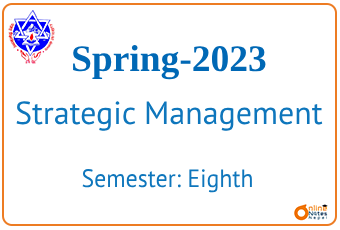Topics


Spring 2023|| Strategic Management || BCIS
For: Class 6
Published By: Mandra Gurung
Published On: 2023-09-07

POKHARA UNIVERSITY
Level: Bachelor Semester: Spring Year: 2023
Programme: BBA/BI/TT/BCIS/BHCM/BHM Full Marks: 100
Course: Strategic Management Pass Marks: 45
Time: 3 hrs.
Section "A"
Very Short Answer Questions
Attempt all the questions. [10x2]
1. Define strategic management.
2. Enlist any four components of strategic vision.
3. Explain the nature of the business environment.
4. List out the types of strategic groups.
5. Give example of backward integration and forward integration each.
6. Write down the advantages of functional organizational structure.
7. Define leadership strategy.
8. Clarify the concept of value chain analysis.
9. Explain any two approaches of internal analysis.
10. Differentiate between strategic control and operational control.
Section "B"
Descriptive Answer Questions
Attempt any six questions. [6×10
11. Briefly describe two important recent changes in the environment of Nepalese business in each of the following areas.
a) Economic
b) Social
c) Political
d) Technological
12. Choose a specific industry relying solely on your impression in Nepal. Evaluate the impact with reference to five forces that drive competition in that industry.
13. The strategic intent with clear strategic direction is important along with adopting strategic flexibility as per the business environment. How do you explain this?
14. How can a company do internal analysis? Explain three of its approaches.
15. Take an example of a multi-product company of your choice and show its four business divisions in four of BCG Matrix quadrants and justify why they are there and also recommend strategy for that company.
16. What do you mean by strategic control? How does it differ from operational control? explain with example
17. Successful strategy formulation does not guarantee successful strategy implementation. Do you agree or disagree with the statement? Support your answer.
Section "C"
Case Analysis
18. Read the case situation given below and answer the questions that follow:
KAVI publication was established in 2002 with an initial capital of 1 billion. Currently, its capital exceeds 50 billion with over 100 staff. It now publishes over 150 books. It does not have explicit vision, mission and objective with no formal resource planning. Initially, it was mostly involved in publishing books on accounts and finance. Later, it involved itself in publishing other books on management of +2 and college level. It also started publishing question bank and exam solution manuals. By 2005, it started publishing books of school levels. Again by 2010, it started publishing science related books. It has also published books on literature and politics. However, it has published very few books on education and humanities. Its market has spread throughout the country.
The publication is managed with simple structure. The managing director is the owner who directs and controls all activities. The delegation of authority and responsibility is very poor. Some of the family members are also involved in the operation of the publication with no defined position. The books of publication are a bit more expensive than the competitors. However, it has been able to attract the readers due to consistency in quality. The publication believed that the readers are ready to pay a certain extra amount for quality. The writers are found satisfied with the royalty they get. Transparency is poor. The publication focuses on standardised ways of writing books. Some writers view this has affected their creativity negatively. Employee turnover is low compared to other publications. Salary and other benefits are good. Like other publications, career development opportunities are seen as poor.
Books in school level and college level are mostly based on personal relationships. For many, quality is secondary. There is tough competition among the publishing houses. The publishing houses are more regulated for the school level by curriculum development centres. There is news that the corporate sector is also interested in the publication business. Currently, it is constructing a high-tech building for its central office. It also plans to open schools and colleges in the near future.
Questions:
a) Explain the corporate and business level strategies followed by the company? Do you agree with these strategies? Explain. [10]
b) Explain the organizational structure adopted by the organization? Is it suitable for structure? Why or why not? [5]
c) If you are managing director of the publication, which strategy do you prefer for the company's betterment? Justify.